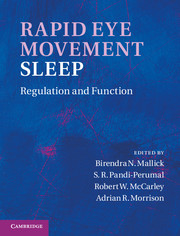Book contents
- Frontmatter
- Contents
- Contributors
- Preface
- Acknowledgments
- Organization
- Section I Historical context
- Section II General biology
- Section III Neuronal regulation
- 10 Understanding REM sleep: clues from brain lesion studies
- 11 Preoptic and basal forebrain modulation of REM sleep
- 12 Amygdalar regulation of REM sleep
- 13 Pontomedullary mediated REM-sleep atonia
- 14 Phenomenology and function of myoclonic twitching in developing rats
- 15 Pontine-wave generator: a key player in REM sleep-dependent memory consolidation
- 16 Hippocampal theta rhythm of REM sleep
- 17 Respiration during REM sleep and its regulation
- 18 Modulation of REM sleep by non-REM sleep and waking areas in the brain
- Section IV Neuroanatomy and neurochemistry
- Section V Functional significance
- Section VI Disturbance in the REM sleep-generating mechanism
- Index
- Plate section
- References
18 - Modulation of REM sleep by non-REM sleep and waking areas in the brain
from Section III - Neuronal regulation
Published online by Cambridge University Press: 07 September 2011
- Frontmatter
- Contents
- Contributors
- Preface
- Acknowledgments
- Organization
- Section I Historical context
- Section II General biology
- Section III Neuronal regulation
- 10 Understanding REM sleep: clues from brain lesion studies
- 11 Preoptic and basal forebrain modulation of REM sleep
- 12 Amygdalar regulation of REM sleep
- 13 Pontomedullary mediated REM-sleep atonia
- 14 Phenomenology and function of myoclonic twitching in developing rats
- 15 Pontine-wave generator: a key player in REM sleep-dependent memory consolidation
- 16 Hippocampal theta rhythm of REM sleep
- 17 Respiration during REM sleep and its regulation
- 18 Modulation of REM sleep by non-REM sleep and waking areas in the brain
- Section IV Neuroanatomy and neurochemistry
- Section V Functional significance
- Section VI Disturbance in the REM sleep-generating mechanism
- Index
- Plate section
- References
Summary
Summary
The brain-stem cholinergic neurons, having higher activity during rapid eye movement (REM) sleep, located in several isolated nuclei are known as REM-on neurons. In contrast, the monoaminergic neurons in the brain stem and in the forebrain areas exhibit higher activity during wakefulness, almost completely cease their firing during REM sleep and have been termed as REM-off neurons. The norepinephrin (NE)-ergic neurons located in the locus coeruleus (LC) could be the negative REM sleep-executive neurons and their cessation during REM sleep seems to be obligatory for its occurrence. Our findings that the wakefulness-promoting neurons are inhibitory to REM-on neurons and excitatory to the REM-off neurons led us to suggest that the wakefulness-related neurons do not allow REM sleep to occur and cessation of REM-off neurons is a necessity for the generation of REM sleep. The caudal brain-stem reticular formation (CRF), which induces cortical synchronization, facilitates the activity of REM-on neurons. However, the hypothalamic non-REM sleep-related neurons do not seem to have significant effect on the spontaneous activity of the REM-on neurons, although they may be indirectly modulating REM sleep. Taken together these findings suggest that normally waking neurons do not allow REM sleep to appear; at a certain depth of non-REM sleep the CRF facilitates the onset of REM sleep and re-activation of the wake-active neurons in the brain stem is requisite for its termination.
- Type
- Chapter
- Information
- Rapid Eye Movement SleepRegulation and Function, pp. 173 - 182Publisher: Cambridge University PressPrint publication year: 2011
References
- 6
- Cited by

